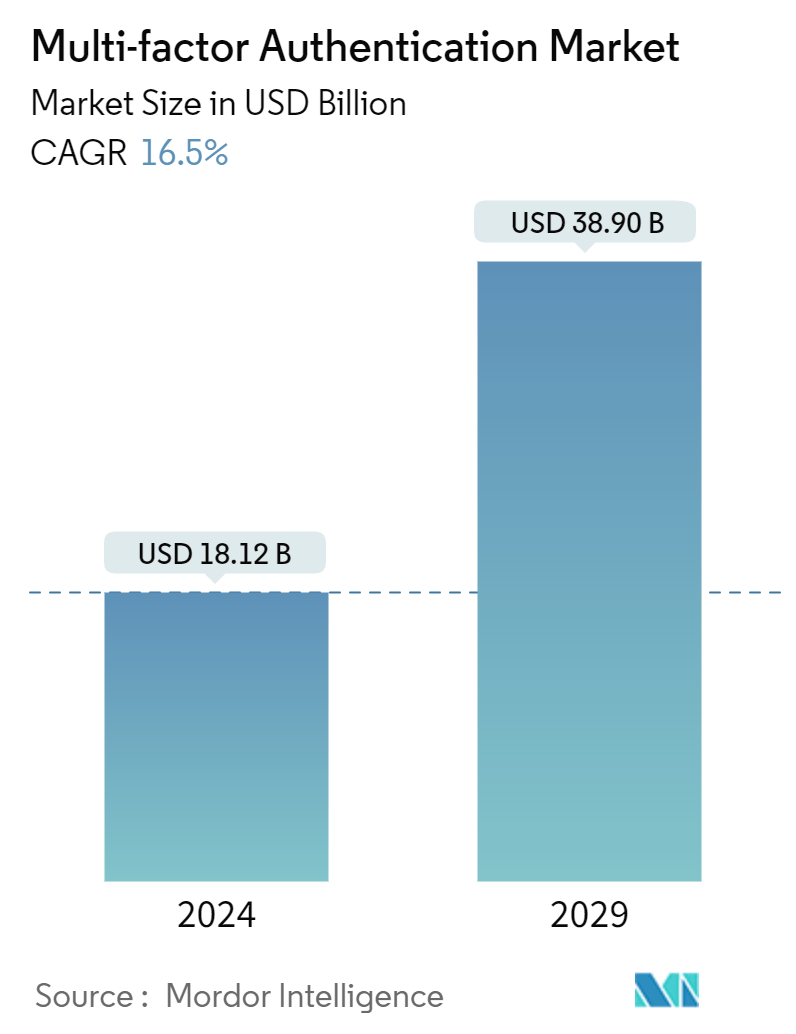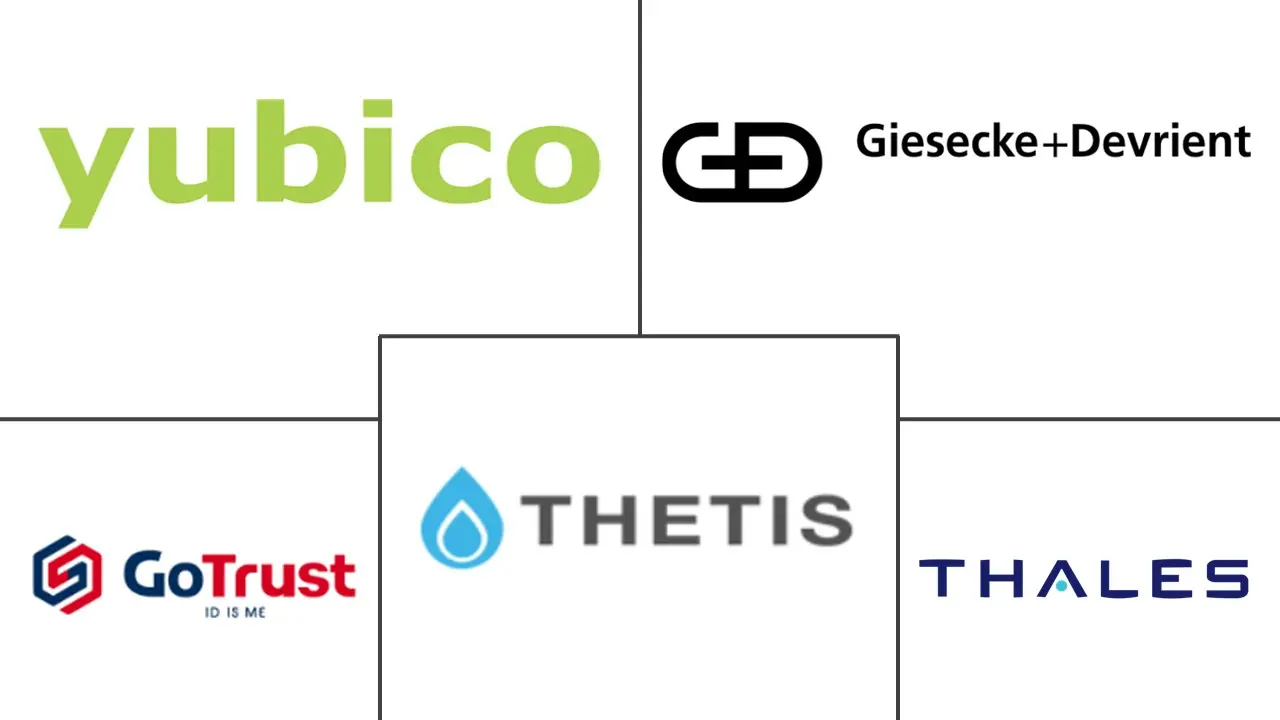Market Size of Multi-factor Authentication Industry

| Study Period | 2019 - 2029 |
| Market Size (2024) | USD 18.12 Billion |
| Market Size (2029) | USD 38.90 Billion |
| CAGR (2024 - 2029) | 16.50 % |
| Fastest Growing Market | Asia Pacific |
| Largest Market | North America |
| Market Concentration | Low |
Major Players
*Disclaimer: Major Players sorted in no particular order |
Multi-factor Authentication Market Analysis
The Multi-factor Authentication Market size is estimated at USD 18.12 billion in 2024, and is expected to reach USD 38.90 billion by 2029, growing at a CAGR of 16.5% during the forecast period (2024-2029).
With the increasing frequency and sophistication of cyber threats, including phishing attacks and data breaches, organizations are pressured to implement strong security measures, such as multi-factor authentication, to protect confidential information and prevent unauthorized access. Strict data protection legislation and compliance standards, including the General Data Protection Regulation, Health Insurance Portability and Accountability Act, and PCI Security Standards, are driving MFA adoption.
To drive demand for multi-factor authentication solutions, regulatory compliance is crucial. Governments and industry regulators worldwide, such as the General Data Protection Regulation, HIPAA, or PCI DSS, have set strict security standards to protect sensitive data. Organizations increasingly rely on MFA as a reliable means of enhancing authentication security to comply with these requirements. The failure to comply with these regulations may lead to significant sanctions and possible judicial consequences, making the implementation of MFA a key element in risk mitigation for companies.
The rising instances of cyber-attacks in various end-user industries, including BFSI, healthcare, IT, and telecom, supported by their increasing usage of the internet to have digitalized operational processes, are fueling the demand for multi-factor authentication (MFA) solutions in the market. MFA adds a layer of protection to the user's access control, endpoint systems, or company data, which effectively helps prevent stolen passwords, malware, phishing, and ransomware attacks.
Multi-factor authentication (MFA) has been significantly used to enhance security measures in the Industrial Internet of Things (IIoT). It helps integrate two or more authentication factors such as biometrics, possession, one-time passwords (OTP), timestamps, challenges, and passwords, which can be used for the secure access of IIOT users, network administrators, and maintenance personnel, driving the demand for NFA solution in the market in line with the growth of IIOT worldwide.
Technology is only one of the components of MFA. Effective data security primarily requires the best practices of MFA, including detailed policies and procedures for handling and storing critical data and dealing with security violations. An effective MFA also depends upon the IT staff’s knowledge of data security requirements and end-user awareness of data security practices.
Furthermore, the Israel-Palestine issue has also prompted an increase in cyber attacks. For instance, various hacktivist groups have targeted critical infrastructure, government agencies, and organizations in both Israel and Palestine. DDoS attacks, defacements, and data breaches are also included in these attacks. As other countries take a stand on the war, the conflict has spread beyond the immediate region, affecting several other countries. Therefore, the growing geopolitical concerns are expected to cause several cyber threats, indicating an upward trend in adopting and implementing cybersecurity strategies and solutions during the forecast period.
Multi-factor Authentication Industry Segmentation
The multi-factor authentication market is defined based on the revenues generated from the hardware, software, and services used in various end-user industries across the globe. The analysis is based on the market insights captured through secondary research and the primaries. The market also covers the major factors impacting the growth of the market in terms of drivers and restraints.
The multi-factor authentication market is segmented by offering type (hardware [token, biometric devices, and other devices], software [authenticator solutions and mobile apps], and services), authentication type (two-factor authentication, three-factor authentication, four-factor authentication, and other types of authentication), end-user industry (banking and financial institutions, cryptocurrency, technology-based companies [SaaS and IT service vendors], government [federal, state, and local entities (including system integrators)], healthcare and pharmaceutical, retail and e-commerce, process-based applications [energy and manufacturing], and other end-user industries [education and immigration]), and geography (North America, Europe, Asia-Pacific, Latin America, and Middle East and Africa). The report offers market sizes and forecasts in terms of value (USD) for all the above segments.
| By Offering Type | |||||
| |||||
| |||||
| Services |
| By Authentication Type | |
| Two-factor Authentication | |
| Three-factor Authentication | |
| Four-factor Authentication | |
| Other Types of Authentication |
| By End-user Industry | |
| Banking and Financial Institutions | |
| Cryptocurrency | |
| Technology-based Companies (SaaS and IT Service Vendors) | |
| Government - Federal, State, and Local Entities (Including System Integrators) | |
| Healthcare and Pharmaceutical | |
| Retail and E-commerce | |
| Process-based Applications - Energy and Manufacturing | |
| Other End-user Verticals - Education, Immigration, Etc. |
| By Geography*** | |||||
| |||||
| |||||
| |||||
| Australia and New Zealand | |||||
| Latin America | |||||
| Middle East and Africa |
Multi-factor Authentication Market Size Summary
The multi-factor authentication (MFA) market is experiencing significant growth, driven by the increasing need for robust security measures to combat the rising frequency and sophistication of cyber threats. Organizations across various sectors, including BFSI, healthcare, and IT & telecom, are adopting MFA solutions to protect sensitive data and comply with stringent regulatory standards such as GDPR, HIPAA, and PCI DSS. The demand for MFA is further fueled by the digital transformation and industrial automation trends, which have expanded the attack surface for cybercriminals. As businesses increasingly rely on cloud-based software and connected devices, the need for secure access and authentication solutions becomes paramount, driving the market's expansion.
In the healthcare sector, the rapid adoption of advanced technologies like AI, ML, and IoT has heightened the focus on cybersecurity, prompting healthcare organizations to invest in MFA solutions to safeguard patient data and ensure compliance. The United States and Canada are witnessing a surge in MFA adoption due to the high volume of cyberattacks and stringent data protection regulations. The market is characterized by a fragmented landscape with both global players and SMEs, engaging in strategic partnerships and acquisitions to enhance their offerings. As cyber threats continue to evolve, the MFA market is poised for substantial growth, with key players like Yubico AB, Giesecke+Devrient GmbH, and Thales leading the charge in developing innovative solutions.
Multi-factor Authentication Market Size - Table of Contents
-
1. MARKET INSIGHTS
-
1.1 Market Overview
-
1.2 Analysis of Macro Economic Scenarios
-
1.3 Insights on the Regulatory Landscape Related to Cyber Security
-
-
2. MARKET SEGMENTATION
-
2.1 By Offering Type
-
2.1.1 Hardware
-
2.1.1.1 Token
-
2.1.1.2 Biometric Devices
-
2.1.1.3 Other Devices
-
-
2.1.2 Software
-
2.1.2.1 Authenticator Solutions
-
2.1.2.2 Mobile Apps
-
-
2.1.3 Services
-
-
2.2 By Authentication Type
-
2.2.1 Two-factor Authentication
-
2.2.2 Three-factor Authentication
-
2.2.3 Four-factor Authentication
-
2.2.4 Other Types of Authentication
-
-
2.3 By End-user Industry
-
2.3.1 Banking and Financial Institutions
-
2.3.2 Cryptocurrency
-
2.3.3 Technology-based Companies (SaaS and IT Service Vendors)
-
2.3.4 Government - Federal, State, and Local Entities (Including System Integrators)
-
2.3.5 Healthcare and Pharmaceutical
-
2.3.6 Retail and E-commerce
-
2.3.7 Process-based Applications - Energy and Manufacturing
-
2.3.8 Other End-user Verticals - Education, Immigration, Etc.
-
-
2.4 By Geography***
-
2.4.1 North America
-
2.4.1.1 United States
-
2.4.1.2 Canada
-
-
2.4.2 Europe
-
2.4.2.1 United Kingdom
-
2.4.2.2 Germany
-
2.4.2.3 France
-
-
2.4.3 Asia
-
2.4.3.1 China
-
2.4.3.2 India
-
2.4.3.3 Japan
-
-
2.4.4 Australia and New Zealand
-
2.4.5 Latin America
-
2.4.6 Middle East and Africa
-
-
Multi-factor Authentication Market Size FAQs
How big is the Multi-factor Authentication Market?
The Multi-factor Authentication Market size is expected to reach USD 18.12 billion in 2024 and grow at a CAGR of 16.5% to reach USD 38.90 billion by 2029.
What is the current Multi-factor Authentication Market size?
In 2024, the Multi-factor Authentication Market size is expected to reach USD 18.12 billion.

